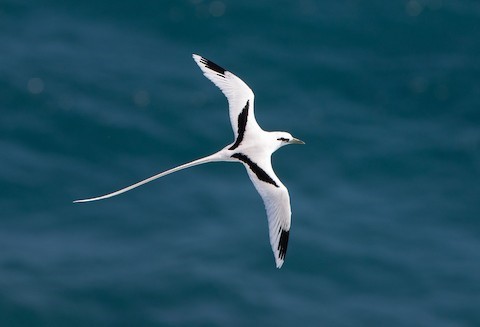Birdfinding.info ⇒ Locally common on and around its breeding grounds scattered across the tropical oceans, but otherwise uncommon and rarely found near continental coasts. Throughout the tropical Pacific, it can be seen at most islands that have cliffs suitable for nesting, including Tahiti and American Samoa. In Hawaii it is easy to find at many sites on Kauai (e.g., Poipu, Waimea Canyon, and Kilauea Point National Wildlife Refuge) and more locally on Oahu (e.g., Ka’ena Point and Waimea Valley), Maui (e.g., Haleakala National Park and Poelua Bay), and the Big Island (e.g., Kilauea Crater, Kealakekua Bay, and Pololu). In Australian waters it is sometimes seen on pelagic trips out of Southport, Queensland, less often elsewhere. In the Indian Ocean it is common in the Seychelles, Mauritius, Réunion, and Christmas Island (where many are vivid “golden” morphs). In the South Atlantic, the most accessible sites are São Tomé and Príncipe, and it is common at the remote islands Fernando de Noronha and Asecnsion.
Yellow-billed Tropicbird
Phaethon lepturus
Pantropical. Breeds on mid-oceanic islands; otherwise exclusively pelagic.
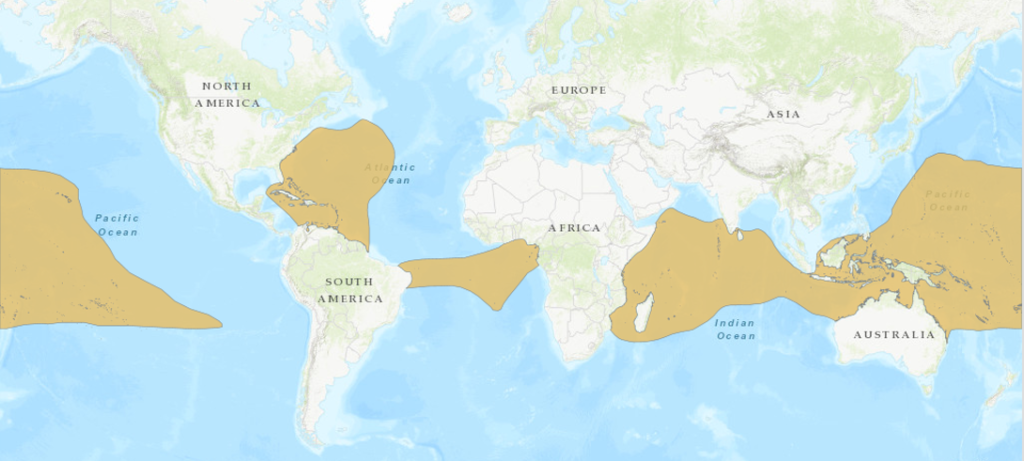
Approximate range of the Yellow-billed Tropicbird (including Catesby’s in the North Atlantic). © BirdLife International 2018
Four or five subspecies are recognized—one in the Pacific, one in the Atlantic, and two or three in the Indian Ocean:
Ascensionis breeds in the equatorial Atlantic on Fernando de Noronha (Brazil), Acension, and islands in the Gulf of Guinea (São Tomé, Príncipe, and Annobón).
Europae breeds on Europa Island in the southern Mozambique Channel.
Lepturus breeds on most tropical island groups of the Indian Ocean: the Comoros, Seychelles, Mauritius, Réunion, Maldives, Chagos, Andaman, and Cocos (Keeling).
Fulvus breeds on Christmas Island in the eastern Indian Ocean—but its status as a subspecies is dubious. It seems to be a localized population of lepturus that has disproportionate representation of “golden” morphs, which also occur to some extent in all other White-tailed subspecies.
Dorotheae breeds on many tropical island groups of the Pacific from the Ogasawara Islands and Palau east throughout Micronesia to Hawaii and south through the Solomon Islands to New Caledonia and throughout Polynesia to Easter Island.
Nonbreeding. Most populations are largely resident around the islands where they breed. Nonbreeding individuals disperse to surrounding seas. Some wander over large expanses of the tropical oceans, and there may be some seasonal movements, but if so they do not appear to be well documented.
Identification
Adult is white overall with two conspicuous black bars on the upperside of each wing, and a yellow bill.
In flight, the adult’s bold black primary and carpal bars distinguish it from other species (except Catesby’s Tropicbird, which is traditionally regarded as conspecific—see below for notes on distinguishing them).
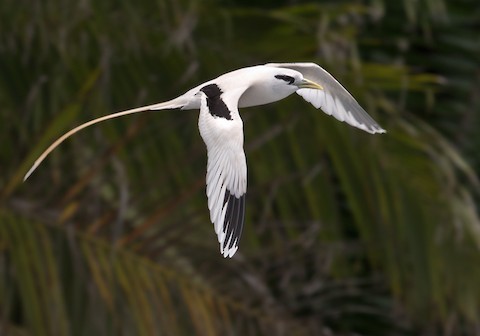
Yellow-billed Tropicbird, P. l. ascensionis. (Príncipe, São Tomé & Príncipe; September 23, 2017.) © Lars Petersson
The several subspecies differ in ways that can be noticeable, with the Indian Ocean’s lepturus being the largest, often showing an orangish bill, and having slightly more black in the primaries (i.e., tending to resemble Catesby’s) and the Pacific dorotheae being the smallest, usually showing a plain, horn-colored bill, and having the most white in the primaries.
The Atlantic ascensionis and europae of the southwestern Indian Ocean are roughly intermediate between the widespread Indian and Pacific subspecies.
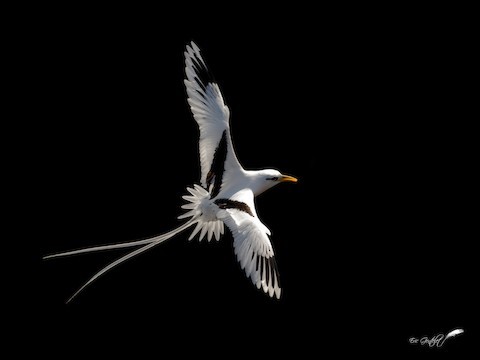
Yellow-billed Tropicbird, P. l. lepturus. (Saint-Pierre, Réunion; April 19, 2020.) © Eric Gentelet
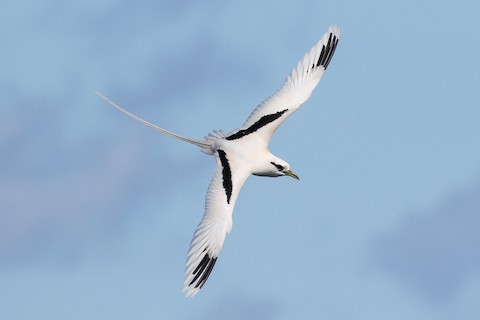
Yellow-billed Tropicbird, P. l. dorotheae. (Kilauea Point National Wildlife Refuge, Kauai, Hawaii; May 14, 2020.) © Eric VanderWerf

Yellow-billed Tropicbird, P. l. dorotheae. (Poipu, Kauai, Hawaii; February 17, 2019.) © Eric Hansen
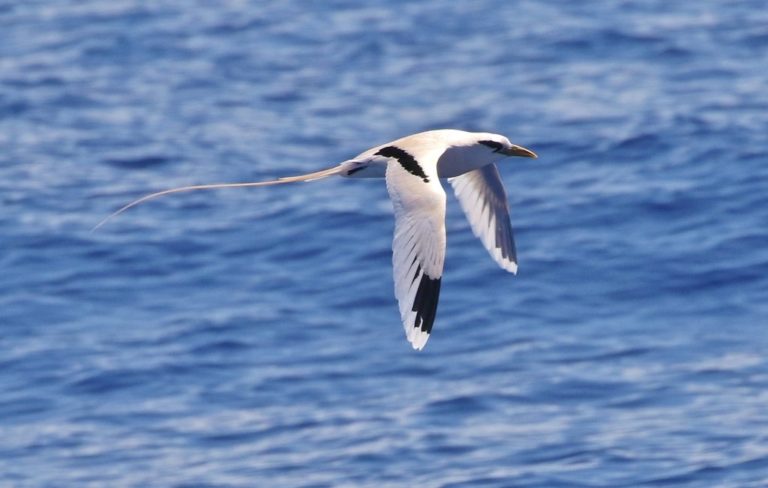
Yellow-billed Tropicbird, P. l. dorotheae. (Offshore from Kailua-Kona, Big Island, Hawaii; September 14, 2018.) © James Bailey
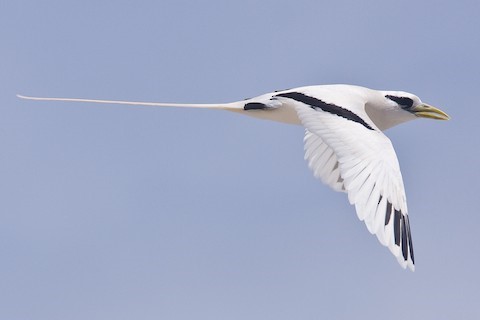
Yellow-billed Tropicbird, P. l. dorotheae. (Wake Island, Hawaii; October 29, 2010.) © Eric VanderWerf

Yellow-billed Tropicbird, P. l. ascensionis. (Fernando de Noronha, Brazil; February 21, 2015.) © Rodrigo Conte
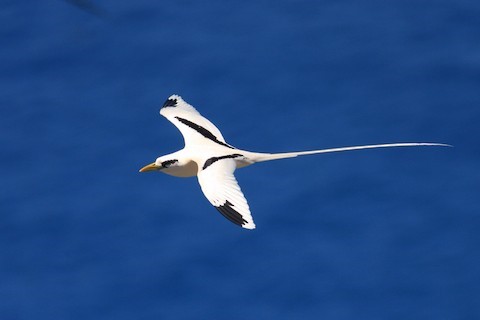
Yellow-billed Tropicbird, P. l. lepturus. (Aride, Seychelles; October 22, 2019.) © Oscar Campbell
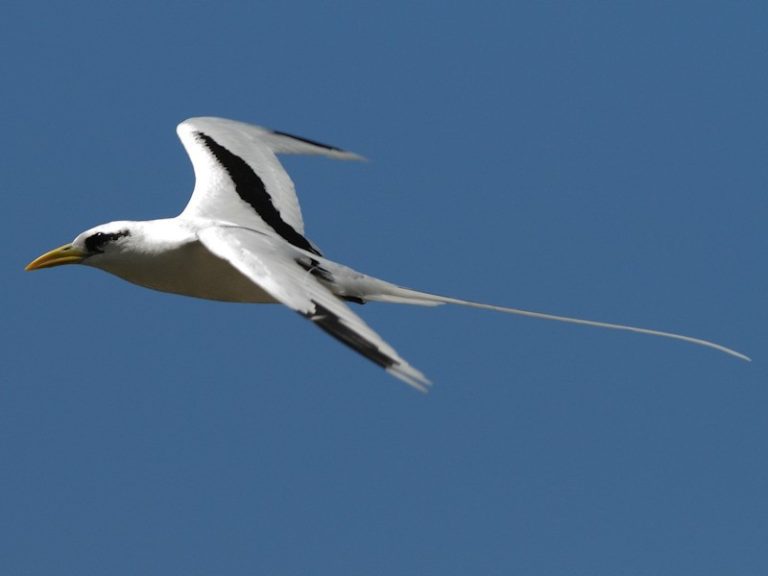
Yellow-billed Tropicbird, P. l. lepturus. (Mahé, Seychelles; October 14, 2007.) © Paolo Mazzei
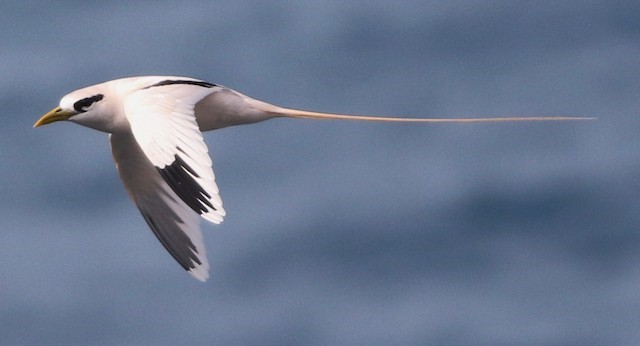
Yellow-billed Tropicbird, P. l. dorotheae, showing a yellowish tinge on the tail. (Kilauea Point National Wildlife Refuge, Kauai, Hawaii; January 2, 2018.) © Derek Stokes

Yellow-billed Tropicbird, P. l. dorotheae, with an unusually dark-looking greenish-yellow bill. (Poipu Cliffs, Kauai, Hawaii; March 23, 2018.) © Russ Morgan
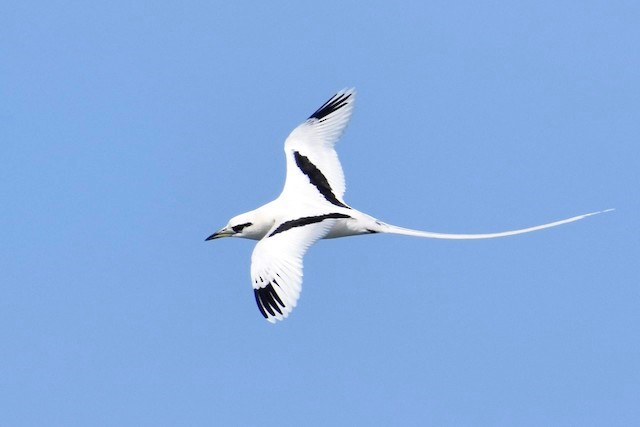
Yellow-billed Tropicbird, P. l. dorotheae, likely a young adult, as its bill has a distinctly dark tip. (Kilauea Point National Wildlife Refuge, Kauai, Hawaii; November 2, 2017.) © Ben Anderson
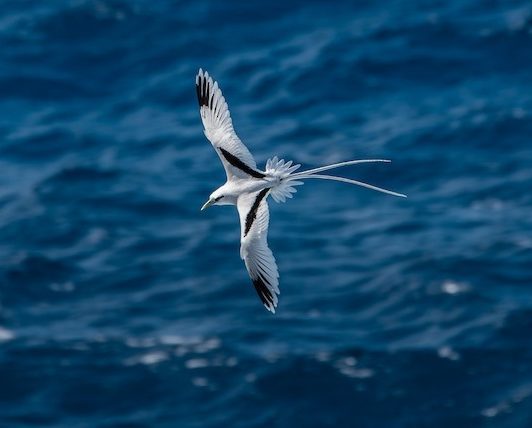
Yellow-billed Tropicbird, P. l. ascensionis. (Fernando de Noronha, Brazil; July 21, 2016.) © Roberto Dall Agnol
The dorsal pattern can often be seen through the wings from below, especially in strong backlighting.

Yellow-billed Tropicbird, P. l. lepturus, with dorsal pattern partly visible from the underside. (Flacq, Mauritius; January 2, 2017.) © Oddfeel

Yellow-billed Tropicbird, P. l. lepturus, with dorsal pattern partly visible from the underside. (Aride, Seychelles; October 23, 2019.) © Oscar Campbell
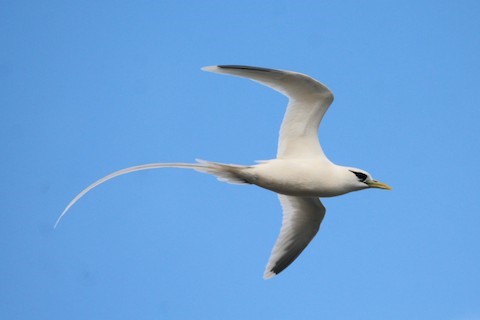
Yellow-billed Tropicbird, P. l. dorotheae, with dorsal pattern partly visible from the underside. (Kilauea Point National Wildlife Refuge, Kauai, Hawaii; December 31, 2019.) © Patrick Sysiong
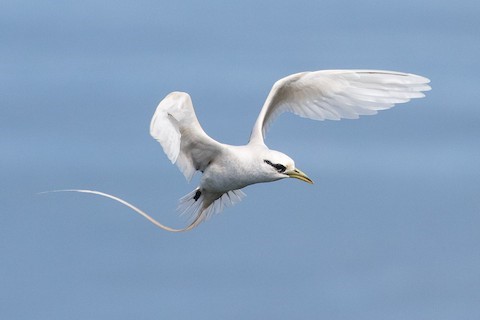
Yellow-billed Tropicbird, P. l. dorotheae, with wings appearing all-white in this view. (Kilauea Point National Wildlife Refuge, Kauai, Hawaii; May 14, 2020.) © Eric VanderWerf
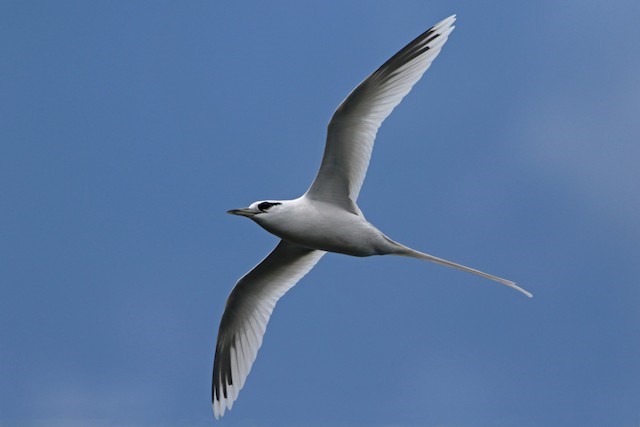
Yellow-billed Tropicbird, P. l. lepturus, with dorsal pattern partly visible from the underside. (Kilauea Point National Wildlife Refuge, Kauai, Hawaii; June 12, 2018.) © Margaret Sloan
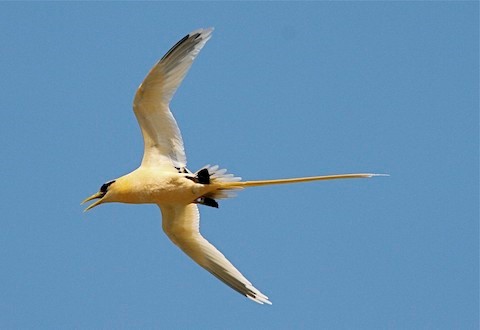
Yellow-billed Tropicbird, P. l. fulvus, golden morph with dorsal pattern partly visible from the underside. (Christmas Island; November 29, 2010.) © Jennifer Spry
At rest, with its wings folded, the adult’s back can appear almost solid black.
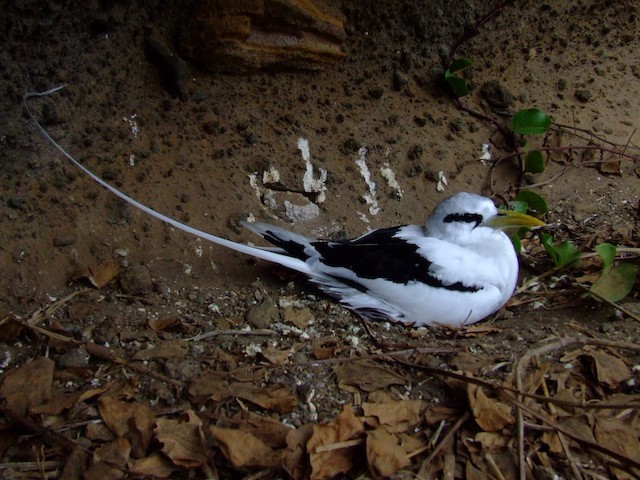
Yellow-billed Tropicbird, P. l. lepturus, on nest, showing largely solid-black upperparts. (Round Island, Mauritius; December 31, 2006.) © Shane McPherson
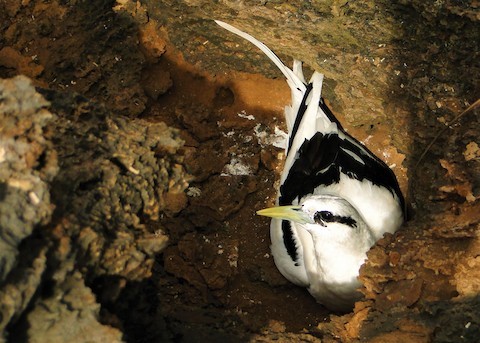
Yellow-billed Tropicbird, P. l. ascensionis, on nest, showing largely solid-black upperparts and bright-yellow bill. (Ilha Rasa, Fernando de Noronha, Brazil; October 6, 2018.) © Carlos Otávio Araujo Gussoni

Yellow-billed Tropicbird, P. l. ascensionis, on nest, showing pale, dull greenish or horn-colored bill. (Boatswain Bird Island, Ascension; April 5, 2018.) © Noah Strycker

Yellow-billed Tropicbird, P. l. lepturus, on nest, showing largely solid-black upperparts. (Aride, Seychelles; October 23, 2019.) © Oscar Campbell
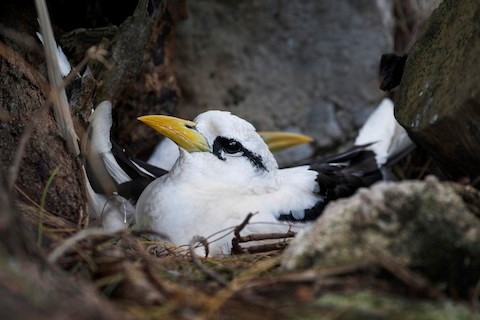
Yellow-billed Tropicbird, P. l. lepturus, on nest, showing orange-yellow bill—much more orange than most Yellow-billed, but not unusual for this subspecies during the breeding season. (Bird Island, Seychelles; December 1, 2019.) © RJ Dodd
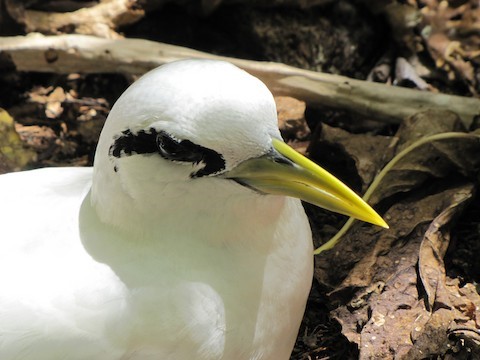
Yellow-billed Tropicbird, P. l. lepturus, on nest, showing bright-yellow bill. (Cousin Island, Seychelles; August 26, 2020.) © Mark Smiles
“Golden” Morphs. All populations of Yellow-billed Tropicbird have some portion that show variable amounts of yellow in their plumage, often concentrated in the tail streamers, sometimes noticeable on the body and wings.
The Christmas Island population (formally recognized as a separate subspecies, fulvus) includes many golden morphs, earning it the nickname “Golden Bosun.” Instead of white overall, many of these individuals are generally yellowish to deep golden-yellow overall. However, many Christmas Island birds are simply white and not distinguishable from typical lepturus.
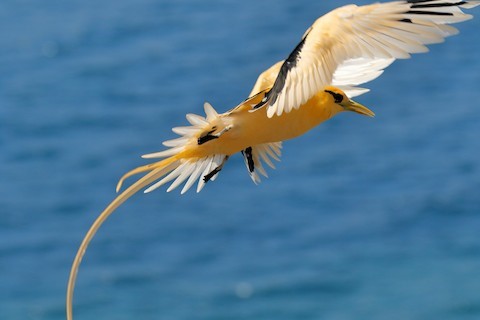
Yellow-billed Tropicbird, P. l. fulvus, among the most golden of golden morphs. (Flying Fish Cove, Christmas Island; August 14, 2015.) © Ian K. Barker
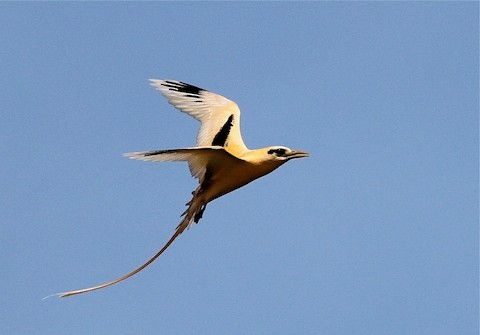
Yellow-billed Tropicbird, P. l. fulvus, golden morph. (Christmas Island; November 29, 2010.) © Jennifer Spry
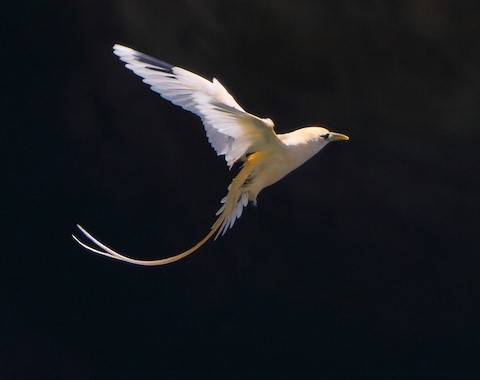
Yellow-billed Tropicbird, P. l. fulvus, golden morph. (Flying Fish Cove, Christmas Island; August 9, 2015.) © Ian K. Barker
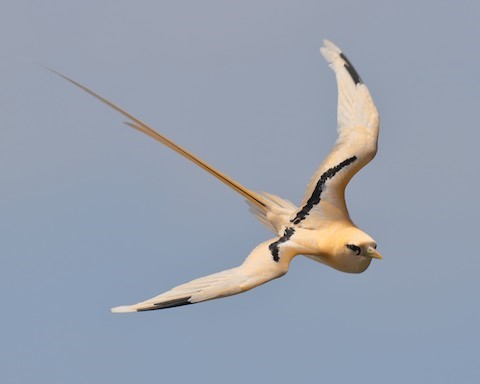
Yellow-billed Tropicbird, P. l. fulvus, golden morph. (Christmas Island; August 15, 2015.) © Ian K. Barker
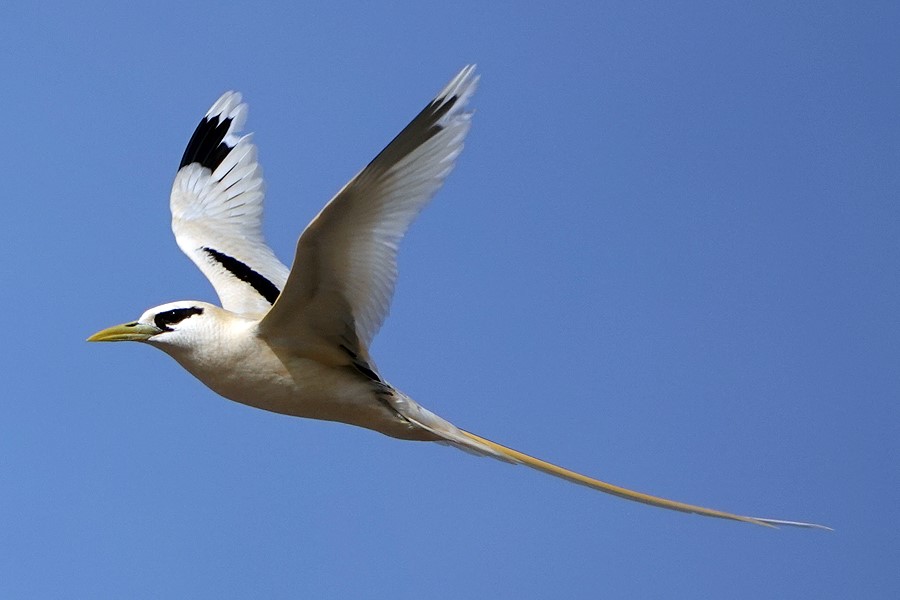
Yellow-billed Tropicbird, P. l. fulvus, subtle golden morph. (Christmas Island; December 3, 2019.) © Carol Kwok
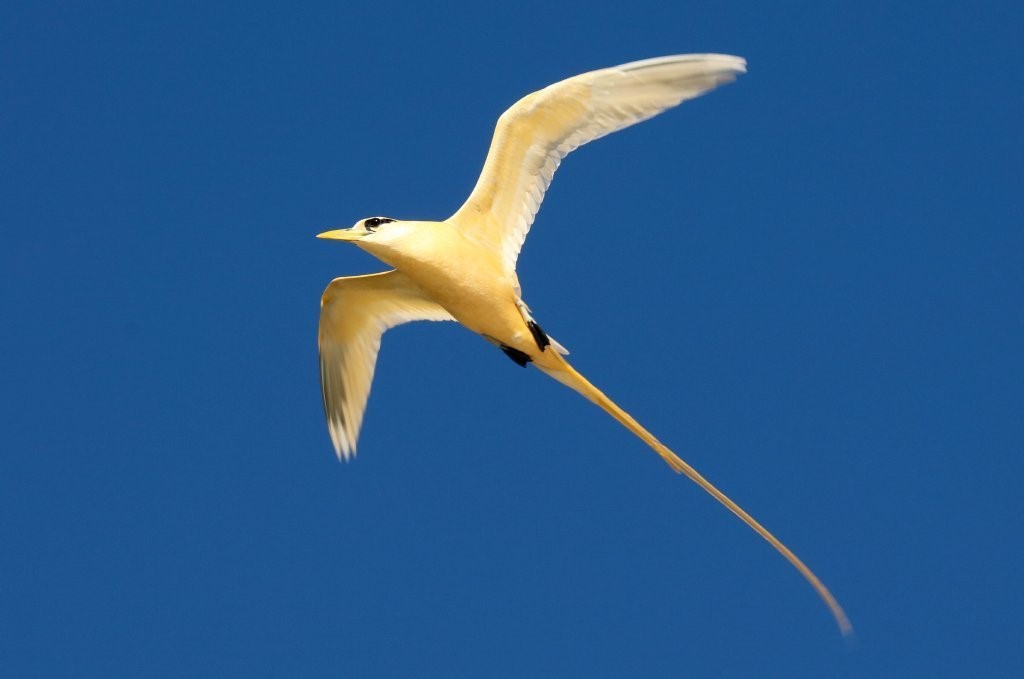
Yellow-billed Tropicbird, P. l. fulvus, golden morph. (Christmas Island; June 30, 2018.) © Hickson Fergusson

Yellow-billed Tropicbird, P. l. fulvus, golden morph. (Christmas Island; August 15, 2015.) © Ian K. Barker
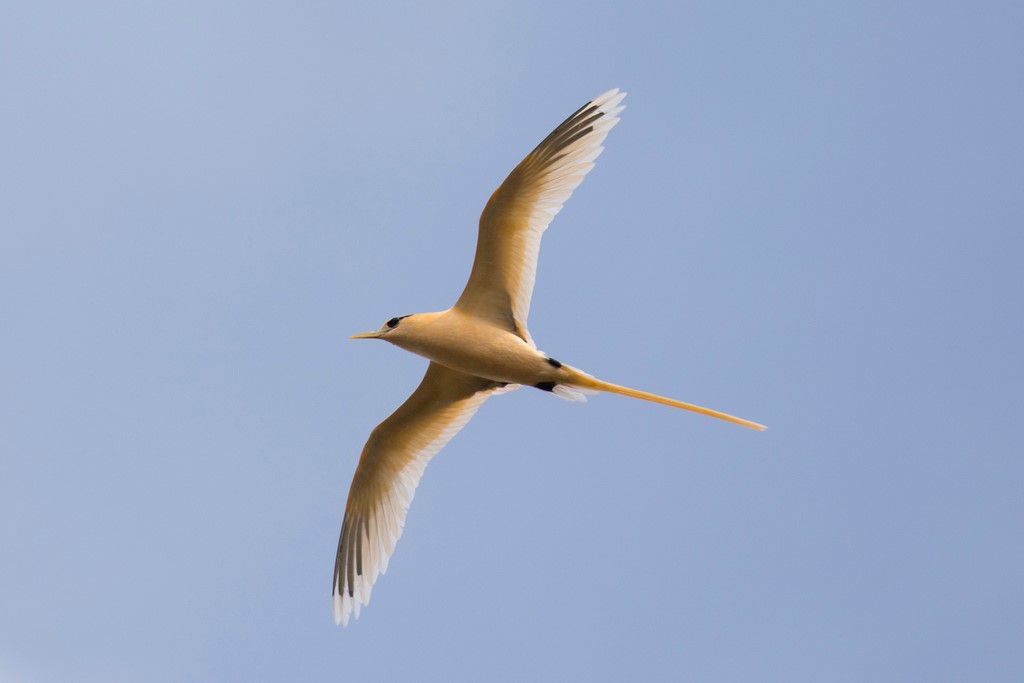
Yellow-billed Tropicbird, P. l. fulvus, golden morph with dorsal pattern partly visible from the underside. (Christmas Island; December 23, 2019.) © hokoonwong

Yellow-billed Tropicbird, P. l. fulvus, golden morph with dorsal pattern partly visible from the underside. (Tai Jin House, Christmas Island; October 3, 2016.) © Bill Bacon
Immature Plumages. The juvenile’s head typically appears mostly white with a slight “eye-shadow” and “teardrop.” Older immatures typically have a broad blackish eyeline that extends back to the nape
The bill is typically pale overall, often darker toward the tip.
Immatures’ upperparts appear generally white with subtle black barring across the back and wing-coverts.
The amount of black visible in immatures’ wings varies. At rest, the folded wings may appear mostly white or mostly black.
In flight, immatures typically show distinct black bars in the outer primaries—similar to the adults’ primaries—but usually lack distinct carpal bars.
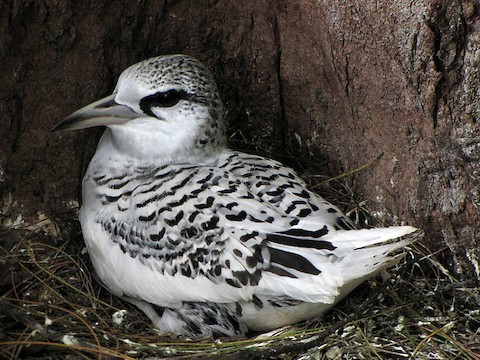
Yellow-billed Tropicbird, P. l. lepturus, juvenile showing heavier-than-average black barring on the upperpart and a pale bill with an extensively blackish tip. (Cousin Island, Seychelles; November 12, 2009.) © Erkki Lehtovirta

Yellow-billed Tropicbird, P. l. dorotheae, immature showing greenish-yellow bill. (Offshore from Southport, Queensland, Australia; February 19, 2011.) © Chris Wiley
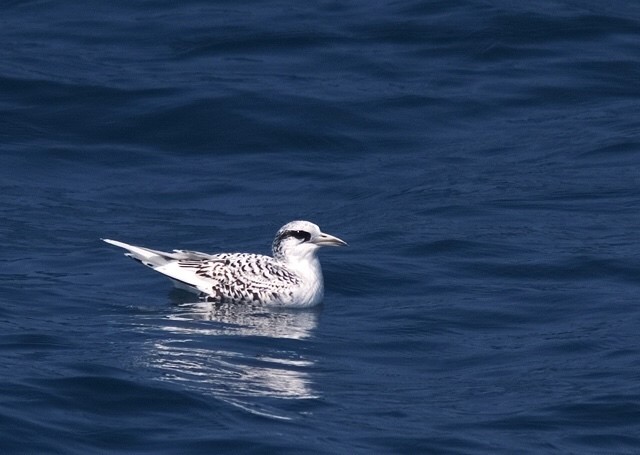
Yellow-billed Tropicbird, P. l. dorotheae, immature showing mostly pale bill with darker tip. (Hong Kong; May 4, 2008.) © carmenor

Yellow-billed Tropicbird, P. l. lepturus, juvenile showing mostly pale bill. (Cousin Island, Seychelles; May 12, 2009.) © sergiocanobbio
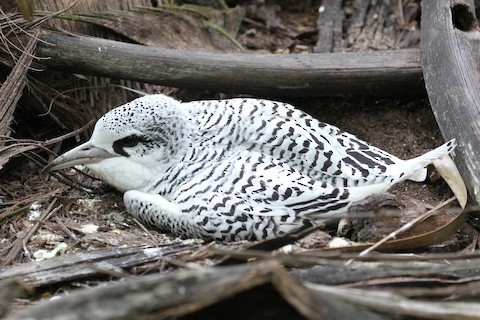
Yellow-billed Tropicbird, P. l. lepturus, juvenile showing mostly pale bill. (Aride, Seychelles; October 23, 2019.) © Oscar Campbell

Yellow-billed Tropicbird, P. l. lepturus, juvenile showing mostly pale bill. (Aride, Seychelles; October 23, 2019.) © Oscar Campbell
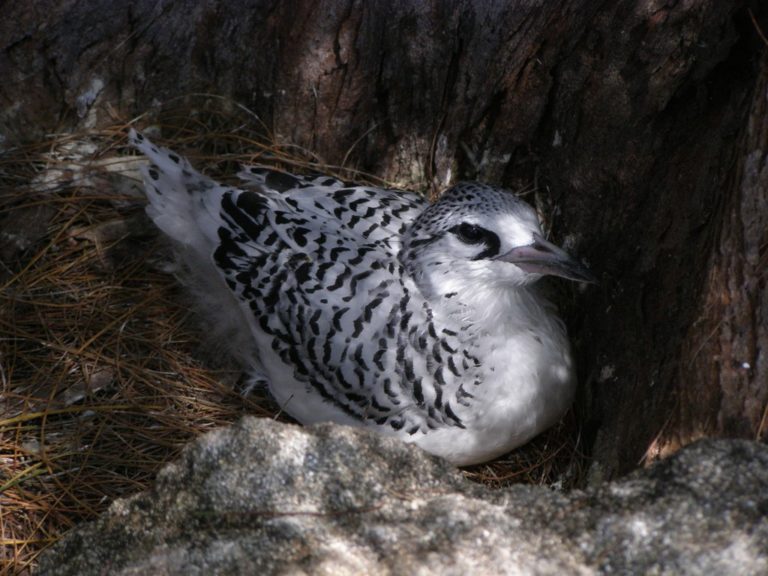
Yellow-billed Tropicbird, P. l. lepturus, juvenile showing heavier-than-average black barring on the upperpart and an apparently dark pinkish bill with an extensively blackish tip. (Bird Island, Seychelles; August 30, 2009.) © Martyn Drabik-Hamshare
Cf. Catesby’s Tropicbird. The tropical Atlantic is home to both Catesby’s and Yellow-billed Tropicbirds. Their ranges overlap widely in Brazilian waters, and both have been recorded from Macaronesia (Catesby’s at least somewhat regularly in the Azores and Yellow-billed twice in Cape Verde). They are extremely similar and can be effectively indistinguishable unless seen well at close range or photographed.
Catesby’s is slightly larger than Yellow-billed, though this would require a close comparison to evaluate. The two differences that are often objective and detectable are bill color and the amounts of black and white on the uppersides of the wingtips.
Bill Color: Catesby’s bill tends to appear more orange than yellow, especially in breeding adults, whereas most Yellow-billed are pale-yellow, often greenish or horn-colored. However, a few Yellow-billed show orange bills (perhaps only briefly, early in the breeding season) and Catesby’s’ bill frequently appear yellow (perhaps mostly on youngish individuals), so there is significant overlap in this feature. For individuals at either end of the spectrum, it is effectively diagnostic, but for those in the middle it is ambiguous.
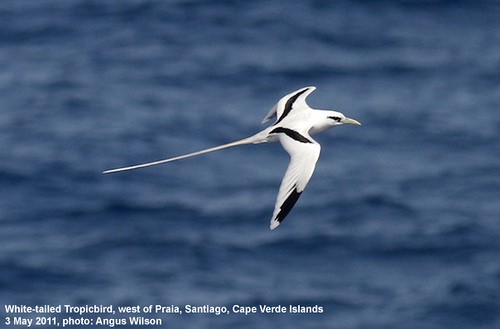
Yellow-billed Tropicbird, P. l. ascensionis, thousands of miles north of its usual range—note pale greenish-yellow bill and white in wingtips. (Offshore west of Praia, Santiago, Ilhas de Sotavento, Cape Verde; May 3, 2011.) © Angus Wilson
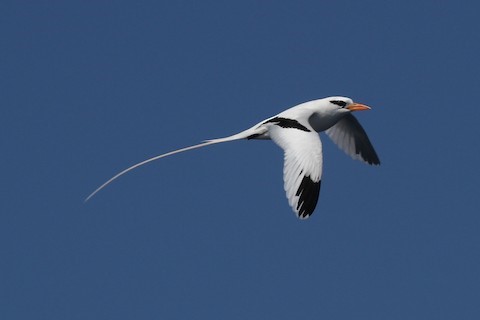
Catesby’s Tropicbird—note orange bill and mostly black wingtips with only small white spots. (Offshore from Cape Hatteras, North Carolina; May 30, 2011.) © Steve Calver
Wingtip Pattern: Probably the most reliable distinction is the pattern of black in the outer primaries. However, this difference is subtle and Yellow-billed appears to vary more internally than it differs from Catesby’s. Both species have extensive black on the outer primaries—generally more on Catesby’s, but they both vary. The objective difference is the amount of white in the tips of the four outermost primaries: an appreciable amount of white on Yellow-billed versus almost none on Catesby’s.
This difference seems to be consistent but it can be confusing because there are borderline cases on both sides of the line: i.e., some Yellow-billed have very little white at the tips of one or two primaries, and some Catesby’s have appreciable white at the tips of one or two primaries, but the two do not quite overlap.
The wingtip distinction can be difficult to interpret in part because on both species the black is usually limited to the outer web of each feather. The inner webs of all the primaries are entirely white, so any feather could potentially appear to have an extensively white tip, depending on how it is exposed. Overall, this feature is useful in most cases (at least for photos and specimens), but hard to apply accurately in some cases.
Cf. Immature Red-tailed Tropicbird. Yellow-billed and Red-tailed Tropicbirds nest on many of the same islands throughout the tropical Indian and Pacific Oceans. Juveniles of the two species are extremely similar. At rest, they may be effectively indistinguishable, except for bill color: juvenile Red-tailed’s is mostly black with a paler gray base, whereas juvenile Yellow-billed’s is mostly pale—pinkish or horn-colored—often darker toward the tip. In flight, the most reliable difference is the amount of black in Yellow-billed’s outer primaries.
Notes
Polytypic species consisting of five recognized subspecies. Traditionally considered conspecific with Catesby’s Tropicbird (P. catesbyi), collectively the White-tailed Tropicbird (P. lepturus), but Howell and Zufelt (2019) recognize it as a separate species, and the evidence in favor of this change is compelling—for a detailed analysis, see Frontiers of Taxonomy: Split the Tropics!
References
BirdLife International. 2018. Phaethon lepturus. The IUCN Red List of Threatened Species 2018: e.T22696645A131756065. (Accessed August 30, 2020.)
eBird. 2020. eBird: An online database of bird distribution and abundance. Cornell Lab of Ornithology, Ithaca, N.Y. http://www.ebird.org. (Accessed August 31, 2020.)
Garcia-del-Rey, E. 2011. Field Guide to the Birds of Macaronesia: Azores, Madeira, Canary Islands, Cape Verde. Lynx Editions, Barcelona.
Harrison, P. 1983. Seabirds: An Identification Guide. Houghton Mifflin, Boston.
Howell, S.N.G., and K. Zufelt. 2019. Oceanic Birds of the World. Princeton University Press.
Le Corre, M. and P. Jouventin. 1999. Geographical variation in the White‐tailed Tropicbird Phaethon lepturus, with the description of a new subspecies endemic to Europa Island, southern Mozambique Channel. Ibis 141(2):233-239.
Pratt, H.D., P.L. Bruner, and D.G. Berrett. 1987. A Field Guide to the Birds of Hawaii and the Tropical Pacific. Princeton University Press.
Pyle, R.L., and P. Pyle. 2017. The Birds of the Hawaiian Islands: Occurrence, History, Distribution, and Status. Version 2 (January 1, 2017). http://hbs.bishopmuseum.org/birds/rlp-monograph/. B.P. Bishop Museum, Honolulu, Hawaii.
Wikiaves. 2020. Rabo-de-palha-de-bico-laranja, https://www.wikiaves.com.br/wiki/rabo-de-palha-de-bico-laranja. (Accessed September 1, 2020.)
